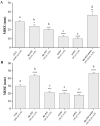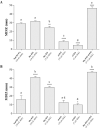Towards Green Strategies of Food Security: Antibacterial Synergy of Essential Oils from Thymus vulgaris and Syzygium aromaticum to Inhibit Escherichia coli and Staphylococcus aureus Pathogenic Food Isolates
- PMID: 36557699
- PMCID: PMC9780947
- DOI: 10.3390/microorganisms10122446
Towards Green Strategies of Food Security: Antibacterial Synergy of Essential Oils from Thymus vulgaris and Syzygium aromaticum to Inhibit Escherichia coli and Staphylococcus aureus Pathogenic Food Isolates
Abstract
Foodborne diseases continue to represent an important public health issue. The control of food spoilage and pathogenic microorganisms is achieved mainly by synthetic chemicals, unfortunately associated to several undesirable aspects. The growing requirement for new and safe alternative strategies has resulted in the research of agents from natural sources with antimicrobial properties, such as essential oils (EOs). This study's purpose was to define the antibacterial profile of thyme (Thymus vulgaris) and cloves (Syzygium aromaticum) essential oils against both Gram-positive and Gram-negative important foodborne pathogenic bacteria. Gas chromatography mass spectrometry analysis was performed for EOs' chemical composition. Qualitative in vitro antimicrobial assays (i.e., agar well diffusion method and disk-volatilization method) allowed for verification of the efficacy of EOs, used individually and in binary combination and both in liquid and vapor phase, against Staphylococcus aureus and Escherichia coli food isolates. Minimal inhibitory concentrations and minimal bactericidal concentration values have been used to quantitatively measure the antibacterial activity of EOs, while the fractional inhibitory concentration index has been considered as a predictor of in vitro antibacterial synergistic effects. The microbiological tests suggest that thyme and cloves EOs, rich in bioactive compounds, are able to inhibit the growth of tested foodborne bacteria, especially in vapor phase, also with synergistic effects. Results provide evidence to consider the tested essential oils as promising sources for development of new, broad-spectrum, green food preservatives.
Keywords: antibacterial agents; antibacterial synergy; essential oils; food pathogens; natural food preservatives.
Conflict of interest statement
The authors declare no conflict of interest.
Figures



Similar articles
-
Antibacterial and Antibiofilm Efficacy of Thyme (Thymus vulgaris L.) Essential Oil against Foodborne Illness Pathogens, Salmonella enterica subsp. enterica Serovar Typhimurium and Bacillus cereus.Antibiotics (Basel). 2023 Feb 28;12(3):485. doi: 10.3390/antibiotics12030485. Antibiotics (Basel). 2023. PMID: 36978352 Free PMC article.
-
Vapor-phase activities of cinnamon, thyme, and oregano essential oils and key constituents against foodborne microorganisms.J Agric Food Chem. 2007 May 30;55(11):4348-56. doi: 10.1021/jf063295u. Epub 2007 May 8. J Agric Food Chem. 2007. PMID: 17488023
-
Synergistic antimicrobial action and effect of active chitosan-gelatin biopolymeric films containing Thymus vulgaris, Ocimum basilicum and Origanum majorana essential oils against Escherichia coli and Staphylococcus aureus.Cell Mol Biol (Noisy-le-grand). 2020 Jun 25;66(4):214-223. Cell Mol Biol (Noisy-le-grand). 2020. PMID: 32583781
-
An Update on Effectiveness and Practicability of Plant Essential Oils in the Food Industry.Plants (Basel). 2022 Sep 22;11(19):2488. doi: 10.3390/plants11192488. Plants (Basel). 2022. PMID: 36235353 Free PMC article. Review.
-
Application of essential oils as antimicrobial agents against spoilage and pathogenic microorganisms in meat products.Int J Food Microbiol. 2021 Jan 16;337:108966. doi: 10.1016/j.ijfoodmicro.2020.108966. Epub 2020 Nov 10. Int J Food Microbiol. 2021. PMID: 33202297 Review.
Cited by
-
Eco-Friendly Sanitization of Indoor Environments: Effectiveness of Thyme Essential Oil in Controlling Bioaerosol Levels and Disinfecting Surfaces.BioTech (Basel). 2024 Apr 26;13(2):12. doi: 10.3390/biotech13020012. BioTech (Basel). 2024. PMID: 38804294 Free PMC article.
-
Exploring Plant Extracts as a Novel Frontier in Antimicrobial Innovation: Plant Extracts and Antimicrobials.Microorganisms. 2024 Feb 27;12(3):483. doi: 10.3390/microorganisms12030483. Microorganisms. 2024. PMID: 38543534 Free PMC article.
-
Chromosome-level genome assembly provides insights into the genome evolution and functional importance of the phenylpropanoid-flavonoid pathway in Thymus mongolicus.BMC Genomics. 2024 Mar 19;25(1):291. doi: 10.1186/s12864-024-10202-8. BMC Genomics. 2024. PMID: 38504151 Free PMC article.
-
Phytochemical Screening and Antibacterial Activity of Commercially Available Essential Oils Combinations with Conventional Antibiotics against Gram-Positive and Gram-Negative Bacteria.Antibiotics (Basel). 2024 May 23;13(6):478. doi: 10.3390/antibiotics13060478. Antibiotics (Basel). 2024. PMID: 38927145 Free PMC article.
-
Thyme Essential Oil as a Potential Tool Against Common and Re-Emerging Foodborne Pathogens: Biocidal Effect on Bacterial Membrane Permeability.Microorganisms. 2024 Dec 27;13(1):37. doi: 10.3390/microorganisms13010037. Microorganisms. 2024. PMID: 39858805 Free PMC article.
References
-
- Hutt P.B., Hutt P.B., II A History of Government Regulation of Adulteration and Misbranding of Food. Food. Drug. Cosmet. Law J. 1989;44:99–117.
-
- Linscott A.J. Food-Borne Illnesses. Clin. Microbiol. Newsl. 2011;33:41–45. doi: 10.1016/j.clinmicnews.2011.02.004. - DOI
-
- Khelissa S.O., Abdallah M., Jama C., Faille C., Chihib N.E. Bacterial Contamination and Biofilm Formation on Abiotic Surfaces and Strategies to Overcome Their Persistence. J. Mater. Environ. Sci. 2017;8:3326–3346.
Grants and funding
LinkOut - more resources
Full Text Sources

